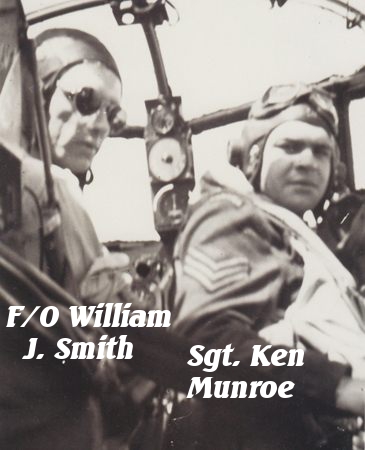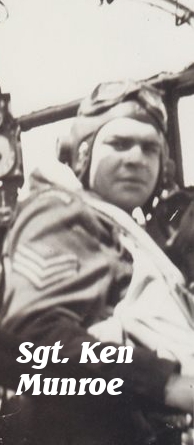419 Beginnings
Sergeant Ken Munroe joined F/O William Smith’s crew at the Heavy Conversion Unit at 76 Base. He and Sgt. Johnny Pratt made up the additional crew necessary to operate the larger Lancaster aircraft. The crew made up of F/S Fred Keizer Navigator, F/O Pete Bell Bomb Aimer, W. McKeen WAG, Sgt. Johhny Pratt Upper gunner and tail gunner Sgt. Francis McCready after their arrival on February 6th now only had to wait for their captains completion of two ops as 2nd. Pilot before the first squadron operation. But one of these original members would not be able to accompany the crew on this first mission.
A Last Minute Replacement
Sgt. Francis McCready the crew's tail gunner through all the days at O.T.U and H.C.U training had now become critically ill and medical necessity required that he return to Canada.
(The full story on Sgt. McCready can be found on this site.)
Sgt. Drinka, who had already flown with the squadron and had survived the January crash of KB722 was to be their new tail gunner.
With the completion of F/O Smith's two 2nd. Dickie stints on February 21st the crew only had to wait for the next listed Battle Order to find themselves part of the squadron’s up coming operation. The target would be Mainz.
First Op.- First Situation
Mainz a city on the upper Rhine had been the target of Bomber Command and the USAAF at least 14 times during the war and on this occasion heavy cloud cover kept the force of over 450 bombers from visually identifying the target area as fully as needed and instead they relied on OBOE.
The bomber force was appeared to be well protected with fighter escort and the heavy cloud cover on this raid. Although even with all this going for Sgt. Muroe and the rest of the crew the skies were not as safe sam as they appeared. The trip would a memorable first op.
The attack on Mainz was a combined day light effort of Bomber Command and the 8th. USAAF and as both large forces crossed the Franco-Belgian border they had a chance to view each other from their different vantage points. Separated only by the different altitudes the 450 Lancasters and other RAF Heavies at one height with rigid formations of B-17s flying on to the target at another altitude.
The bombing run was completed and reported as being as satisfactory. Then at some point over the target area his aircraft was attacked by an unidentified enemy night fighter punching two holes in the port outer engine nacelle. The only action to do was to feather the engine which they managed to complete as they left the target area. From then on F/E Munroe was busy keeping an eye on his remaining engines and monitoring fuel reserves as the aircraft headed back to base. The actual details of this attack are barely mentioned in the squadron log nor are there any Combat Reports found on the attack. ( As a side note the Lancaster, VR-D, which was Lancaster hit by this enemy fire was the aircraft my father as ground crew Sergeant was responsible for maintaining.)
Another Thirteen Operations
For Sgt.Munroe the first operation provided an opportunity to utilize some of the skills that he had gained during his training. For the next thirteen operations, he would find himself almost constantly over Germany in the heavily defended areas such as the Ruhr Valley.
On the evening of April 16/17 1945, Munroe and the crew were on one of the last operations of the air war for 419 squadron. Within a few days the squadron's pilots and navigators were being prepared for a new challenge. And while the final few missions were on, the plans for getting the Lancasters back to Canada was being put in place.
A Hop Across the Atlantic
With his final operation completed on his return to base on April 17th. There were only a few more operations carried out by the squadron and even some of those were recalled while the aircraft were either being marshalled for take off or on their way to the targets.
The next weeks were crammed with training of a new type, for at least the Navigators and the Pilots. Cross country jaunts navigated by Astronavigation were conducted by all crews. Planned flights from point to point and then returning to base were carried out quite successfully by the crews. The flight across the Atlantic, first finding the small land mass of the Azores then flying off across the wide Atlantic to Gander Newfoundland would require precision flying.
By June 10th Sgt. Ken Munroe and the crew of Linden Rose were back safely in Canada. By September the war was over in the Pacific and Sgt. Munroe along with the whole of Moose Squadron found their way back home to every corner of Canada and the U.S.



